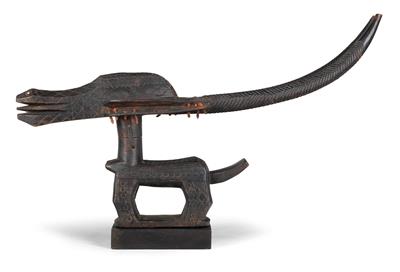Bambara (or Bamana), Mali: a dance crest, known as ‘chiwara’, in the form of a female antelope.
Bambara (or Bamana), Mali: a dance crest, known as ‘chiwara’, in the form of a female antelope.

This horizontal type, from the region of the capital city Bamako, is also known as a ‘sogonikun’ dance crest. Among the Bambara (also called Bamana), workers of the land in the Mali savanna, two young men dance with such antelope crests, known as ‘chiwara’ on their heads and wearing floor-length, black costumes of fibres. The aim of the ritual is to increase and secure fertility of the fields. During the dance, the antelope dance crests are tied to plaited caps. The present ‘chiwara dance crest’ depicts a female antelope, shaped in the horizontal type of ‘sogonikun’, which is typical in the territory around the capital of Mali, Bamako. The antelope is carved in two pieces of hard, brown wood and dyed black. Head and body are connected at the neck through two iron staples. The long horns, which are slightly and elegantly curved upwards, bear deeply carved relief lines. On the lower end of the horns, behind the head, a small human figure was probably glued on as an addition. Remains of black tree resin are still recognisable there.
The actual head section is decorated above, on both sides, each with two broad, horizontal zigzag lines, and on the remaining surfaces with double, fine incised lines in cross form. The pointed, long ears lie horizontally on both sides. They are pierced below, and decorated with knotted, red cotton tassels. Some tassels are missing (lost), as a result of protracted use of the object. The muzzle of the antelope is widely protruding, with open mouth and tongue. On the nose is preserved a continuous hole, where a metal ring or a red cotton tassel was once attached as decoration (as on the ears). The body of the female antelope displays on the front (human) breasts, a slightly curved, angular small tail, and is decorated on the exterior surfaces with fine lines and stamped circles. The entire object shows a good usage patina and slight colour scuffing on some edges, through protracted use. The base plate and the four holes, for attaching the ‘chiwara’ onto the plaited cap, bear noticeable traces of use. No significant damage.
Height: c. 40 cm; length: 67 cm. First half of the 20th century. (ME)
Provenance: German collection.
Lit.: ‘Bamana’ by Jean-Paul Colleyn, ill. 44–50.
Specialist: Erwin Melchardt
 Erwin Melchardt
Erwin Melchardt
+43-1-515 60-465
erwin.melchardt@dorotheum.at
06.04.2017 - 15:00
- Realized price: **
-
EUR 1,625.-
- Starting bid:
-
EUR 1,000.-
Bambara (or Bamana), Mali: a dance crest, known as ‘chiwara’, in the form of a female antelope.
This horizontal type, from the region of the capital city Bamako, is also known as a ‘sogonikun’ dance crest. Among the Bambara (also called Bamana), workers of the land in the Mali savanna, two young men dance with such antelope crests, known as ‘chiwara’ on their heads and wearing floor-length, black costumes of fibres. The aim of the ritual is to increase and secure fertility of the fields. During the dance, the antelope dance crests are tied to plaited caps. The present ‘chiwara dance crest’ depicts a female antelope, shaped in the horizontal type of ‘sogonikun’, which is typical in the territory around the capital of Mali, Bamako. The antelope is carved in two pieces of hard, brown wood and dyed black. Head and body are connected at the neck through two iron staples. The long horns, which are slightly and elegantly curved upwards, bear deeply carved relief lines. On the lower end of the horns, behind the head, a small human figure was probably glued on as an addition. Remains of black tree resin are still recognisable there.
The actual head section is decorated above, on both sides, each with two broad, horizontal zigzag lines, and on the remaining surfaces with double, fine incised lines in cross form. The pointed, long ears lie horizontally on both sides. They are pierced below, and decorated with knotted, red cotton tassels. Some tassels are missing (lost), as a result of protracted use of the object. The muzzle of the antelope is widely protruding, with open mouth and tongue. On the nose is preserved a continuous hole, where a metal ring or a red cotton tassel was once attached as decoration (as on the ears). The body of the female antelope displays on the front (human) breasts, a slightly curved, angular small tail, and is decorated on the exterior surfaces with fine lines and stamped circles. The entire object shows a good usage patina and slight colour scuffing on some edges, through protracted use. The base plate and the four holes, for attaching the ‘chiwara’ onto the plaited cap, bear noticeable traces of use. No significant damage.
Height: c. 40 cm; length: 67 cm. First half of the 20th century. (ME)
Provenance: German collection.
Lit.: ‘Bamana’ by Jean-Paul Colleyn, ill. 44–50.
Specialist: Erwin Melchardt
 Erwin Melchardt
Erwin Melchardt
+43-1-515 60-465
erwin.melchardt@dorotheum.at
|
Buyers hotline
Mon.-Fri.: 10.00am - 5.00pm
kundendienst@dorotheum.at +43 1 515 60 200 |
| Auction: | Tribal Art |
| Auction type: | Saleroom auction |
| Date: | 06.04.2017 - 15:00 |
| Location: | Vienna | Palais Dorotheum |
| Exhibition: | 01.04. - 06.04.2017 |
** Purchase price incl. charges and taxes
It is not possible to turn in online buying orders anymore. The auction is in preparation or has been executed already.
